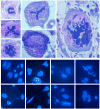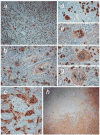Fibroblasts from Werner syndrome patients: cancer cells derived by experimental introduction of oncogenes maintain malignant properties despite entering crisis
- PMID: 20043098
- PMCID: PMC3743249
Fibroblasts from Werner syndrome patients: cancer cells derived by experimental introduction of oncogenes maintain malignant properties despite entering crisis
Abstract
Werner syndrome (WS) results from defects in the gene encoding WRN RecQ helicase. WS fibroblasts undergo premature senescence in culture. Because cellular senescence is a tumor suppressor mechanism, we examined whether WS fibroblasts exhibited reduced tumorigenicity, in comparison to control cells, in a model of experimental conversion of normal human cells to cancer cells. The combination of oncogenic Ras (Ha-Ras(V12G)) and SV40 large T antigen (SV40 LT) causes human cells to acquire neoplastic properties in the absence of telomerase. We found that WS cells could also be converted to a tumorigenic state by these oncogenes, as evidenced by invasion and metastasis of cells implanted in immunodeficient mice. Ras/SV40 LT-expressing cells retained invasiveness and malignant properties even when cells reached crisis in tumors in vivo. High levels of gelatinase were found by an in situ assay in Ras/SV40 LT-expressing cells undergoing crisis. We conclude that, despite evidence of accelerated senescence in WS cells, there is no evidence that the absence of active WRN acts as a barrier to neoplastic transformation. Moreover, we find that tumorigenic human cells retain malignant properties of the cells as they approach and reach crisis.
Conflict of interest statement
Figures








Similar articles
-
Progressive loss of malignant behavior in telomerase-negative tumorigenic adrenocortical cells and restoration of tumorigenicity by human telomerase reverse transcriptase.Cancer Res. 2004 Sep 1;64(17):6144-51. doi: 10.1158/0008-5472.CAN-04-1376. Cancer Res. 2004. PMID: 15342398
-
Resistance to experimental tumorigenesis in cells of a long-lived mammal, the naked mole-rat (Heterocephalus glaber).Aging Cell. 2010 Aug;9(4):626-35. doi: 10.1111/j.1474-9726.2010.00588.x. Epub 2010 Jun 9. Aging Cell. 2010. PMID: 20550519 Free PMC article.
-
Multiple stages of malignant transformation of human endothelial cells modelled by co-expression of telomerase reverse transcriptase, SV40 T antigen and oncogenic N-ras.Oncogene. 2002 Jun 20;21(27):4200-11. doi: 10.1038/sj.onc.1205425. Oncogene. 2002. PMID: 12082607
-
Senescence as a mode of tumor suppression.Environ Health Perspect. 1991 Jun;93:59-62. doi: 10.1289/ehp.919359. Environ Health Perspect. 1991. PMID: 1663451 Free PMC article. Review.
-
Mechanisms of oncogene cooperation: activation and inactivation of a growth antagonist.Environ Health Perspect. 1991 Jun;93:97-103. doi: 10.1289/ehp.919397. Environ Health Perspect. 1991. PMID: 1837777 Free PMC article. Review.
Cited by
-
The Contribution of Physiological and Accelerated Aging to Cancer Progression Through Senescence-Induced Inflammation.Front Oncol. 2021 Sep 21;11:747822. doi: 10.3389/fonc.2021.747822. eCollection 2021. Front Oncol. 2021. PMID: 34621683 Free PMC article. Review.
References
-
- Ostler EL, Wallis CV, Sheerin AN, Faragher RG. A model for the phenotypic presentation of Werner's syndrome. Exp Gerontol. 2002;37:285–92. - PubMed
-
- Goto M, Miller RW, Ishikawa Y, Sugano H. Excess of rare cancers in Werner syndrome (adult progeria) Cancer Epidemiol Biomarkers Prev. 1996;5:239–46. - PubMed
Publication types
MeSH terms
Substances
Grants and funding
LinkOut - more resources
Full Text Sources
Research Materials

